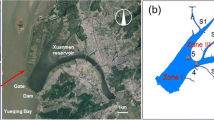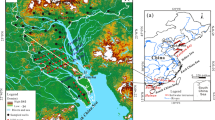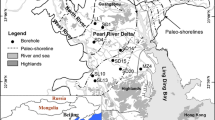Abstract
Electrical conductivity (EC) and geochemical data were interpreted to determine the nature, origin and distribution of salinity in pore waters of sediments in a deltaic environment. The role of diffusion as a mechanism for transporting saline water within lower permeability prodelta and delta slope sediments is specifically investigated. Characteristic vertical salinity profiles at several different regions of the Fraser River Delta, British Columbia (Canada) are identified, including relatively shallow salinity zones in areas currently and historically near main river channels, and deeper salinity zones reaching up to 300 m depth in delta-front and inland areas. Comparison of salinity profiles with the results of a simple salt transport model suggests that diffusion may be a significant mechanism controlling the observed distribution of salinity in current or former estuarine areas of the delta.Density-effects were found not to be significant given the low permeability of the silt through which the salt is diffusing; however, in similar environments with higher permeability sediments, density effects may be significant. In inland and delta front areas, salinity extends to a considerable depth in the silts, beyond what would appear to be possible by diffusion alone, and points to a connate origin.
Resumé
La conductivité électrique (EC) et des données géochimiques ont été interprétées pour déterminer la nature, l’origine et la distribution de la salinité dans l’eau souterraine des sédiments d’un environnement deltaïque. Le rôle de la diffusion, en tant que mécanisme de transport de l’eau salée au travers des perméabilités plus faibles du prodelta et du delta, est plus particulièrement investiguée. Les profiles verticaux de salinité dans différentes parties du Delta de la Fraser, Colombie Britannique (Canada) ont été identifiés, incluant les zones de salinité de sub-surface proches des lits mineurs actuels et historiques, ainsi que les zones de salinité plus profonde (300 m) sur le front du delta et à l’intérieur des terres. La comparaison des profils de salinité et d’un simple modèle de transport de sels, suggère que la diffusion pourrait être un mécanisme significatif du contrôle de la salinité dans les zones des estuaires actuels ou passés du delta. Les effets de densité ne sont pas significatifs au regard de la faible conductivité hydraulique du silt à travers duquel le sel diffuse ; néanmoins, dans des environnements similaires et des sédiments perméables plus importants, les effets de la densité seraient plus importants. Dans les zones de front du delta et de l’intérieur des terres, la salinité s’étend à des profondeurs considérables dans les silts, au-delà d’un point qui ne serait justifié que par la diffusion ou la présence d’eaux connées.
Resumen
Se han interpretado datos de conductividad eléctrica y geoquímicos para determinar la naturaleza, origen y distribución de la salinidad en aguas intersticiales de sedimentos en un ambiente deltaico. Se investiga en detalle el papel de la difusión como un mecanismo para transportar agua salada en un ambiente prodelta de baja permeabilidad y sedimentos en ladera del delta. Se identifican perfiles verticales característicos de salinidad en varias regiones del Delta Rio Fraser, Columbia Británica (Canada) incluyendo zonas salinas relativamente someras en áreas que histórica y actualmente se ubican cerca de los canales fluviales principales, y zonas de salinidad más profunda que alcanzan hasta 300m de profundidad en áreas tierra adentro y en la parte frontal del delta. La comparación de los perfiles de salinidad con los resultados de un modelo simple de transporte de sales sugieren que la difusión puede ser un mecanismo significativo que controla la distribución observada de la salinidad en estuarios actuales o antiguos del delta. Se encontró que los efectos de la densidad no son significativos dada la baja permeabilidad del limo a través del cual se mueve la sal; sin embargo, en ambientes similares con sedimentos de mayor permeabilidad los efectos de la densidad si pueden ser significativos. Tierra adentro y en los frentes deltaicos la salinidad se extiende a considerable profundidad en los limos, más allá de lo que pudiera ser factible en base al mecanismo de difusión por sí solo, lo que indica un origen connato.















Similar content being viewed by others
References
Ages A, Wollard A (1976) The tides of the Fraser river estuary, Pacific Marine Science Report 76-5, Institute of Ocean Sciences, Sidney, British Columbia
Bazett DJ, McCammon NR (1986) Foundations of the Annacis cable-stayed bridge. Can Geotech J 23:458–471
Clague JJ (1977) Quadra sand: a study of the late Pleistocene geology and geomorphology of coastal southwest British Columbia, Paper 77–17, Geological Survey of Canada, Ottawa, Ontario, p 24
Clague JJ (1998) Geologic setting of the Fraser River Delta. In: Clague JJ Luternauer JL, Mosher DC (eds) Geology and natural hazards of the Fraser River Delta, British Columbia. Geol Surv Can Bull 525:7–16
Clague JJ, Luternauer JL, Hebda RJ (1983) Sedimentary environments and postglacial history of the Fraser Delta and lower Fraser valley, British Columbia. Can J Earth Sci 20:1314–1426
Clague JJ, Luternauer JL, Pullan SE, Hunter JA (1991) Postglacial deltaic sediments, southern Fraser River Delta, British Columbia. Can J Earth Sci 28:1386–1393
Clague JJ, Luternauer JL Monahan PA, Edwardson KA, Dallimore SR, Hunter JA (1998) Quaternary stratigraphy and evolution of the Fraser Delta. In: Clague JJ, Luternauer JL, Mosher DC (eds) Geology and natural hazards of the Fraser River Delta, British Columbia. Geol Surv Can Bull 525:57–90
Christian HA, Barrie JV, MacDonald R, Monahan PA, Hunter JA, Luternauer JL (1995) Slope instability on Roberts Bank, Fraser River Delta, British Columbia. In: Proceedings of the Canadian Geotechnical Conference. Vancouver, British Columbia, Preprint Volume 2, pp 937–946
Christian HA, Mosher DC, Barrie JV, Hunter JA, Luternauer JL (1998) Seabed slope instability on the Fraser River Delta. In: Clague JJ Luternauer JL, Mosher DC (eds) Geology and natural hazards of the Fraser River Delta, British Columbia. Geol Surv Can Bull 525:217–230
Cornett RJ, Risto BA, Lee DR (1989) Measuring groundwater transport through lake sediments by advection and diffusion. Water Resour Res 25(8):1815–1823
Custodio E (1997) Studying, monitoring and controlling seawater intrusion in coastal aquifers. In: Guidelines for study, monitoring and control. FAO Water Reports No. 11, FAO, Rome, pp 7–23
Dallimore SR, Edwardson KA, Hunter JA Clague JJ, Luternauer JL (1995) Composite geotechnical logs for two deep boreholes in the Fraser River Delta, British Columbia; Geological Survey of Canada Open File, 3018, 1 sheet, Geological Survey of Canada, Ottawa, Ontario
Dazy J, Droque C, Charmanidis P, Darlet C (1997) The influence of marine inflows on chemical composition of groundwater in small islands: the example of the Cyclades (Greece). Environ Geol 31:133–141
De Marsily G (1986) Quantitative hydrogeology. Academic Press, Orlando, Florida
De Vries JJ (1981) Fresh and salt groundwater in the Dutch coastal in relation to geomorphological evolution. Geol Mijnb 60:363–368
Environment Canada (1974) Water Quality Data, British Columbia 1961–1971, Inland Waters Directorate, Water Quality Branch, Environment Canada, Gatineau, Quebec
Fofonoff P, Millard RC (1983) Algorithms for computation of fundamental properties of seawater. UNESCO Tech Pap Mar Sci 44:53
Groen J, Velstra J, Meesters AGCA (2000) Salinization processes in paleowaters in coastal sediments of Suriname: evidence (super 37) Cl analysis and diffusion modelling. J Hydrol 234:1–20
Guiger N, Franz T (1995) Visual MODFLOW for Windows, version 2.60. Waterloo Hydrogeologic Software, Waterloo, Canada
Hunter JA, Luternauer JL, Roberts MC, Monahan PA, Douma M (1994) Borehole geophysical logs, Fraser River Delta (92G), British Columbia, Geological Survey of Canada Open File, 3359, Geological Survey of Canada, Ottawa, Ontario
Hunter JA, Douma M, Burns RA, Good RL, Pullan SE, Harris JB, Luternauer JL, Best ME (1998) Testing and application of near-surface geophysical techniques for earthquake hazard studies, Fraser River Delta, British Columbia. In: Clague JJ, Luternauer JL, Mosher DC (eds) Geology and natural hazards of the Fraser River Delta, British Columbia. Geol Surv Can Bull 525:123–145
Jones BF, Vengosh A, Rosenthal A, Yechieli Y (1999) Geochemical investigations. In: Bear J, Cheng AH-D, Sorek S, Ouazar D, Herrera H (eds) Seawater intrusion in coastal aquifers-concepts, methods, and practices. Kluwer, Dordrecht
Keller CK, van der Kamp G, Cherry JA (1991) Hydrogeochemistry of a clayey till 1-spatial variability. Water Resour Res 27(10):2543–2554
Kooi J, Groen J, Leijnse A (2000) Modes of seawater instrusion during transgressions. Water Resour Res 36(12):3581–3589
Li Y-H, Gregory S (1974) Diffusion of ions in sea water and in deep-sea sediments. Geochim Cosmochim Acta 38:703–714
Lloyd JW, Howard KWF, Pacey NR, Tellam JH (1982) The value of iodide as a parameter in the chemical characterisation of groundwaters. J Hydrol 57:247–265
Manheim FT, Paull CK (1981) Patterns of groundwater salinity changes in a deep continental-oceanic transect off the southeastern Atlantic coast of the USA. J Hydrol 54:95–105
Mathews WH, Shepard FP (1962) Sedimentation in the Fraser River Delta and its estuary, British Columbia. AAPG Bull 46:1416–1443
Mosher DC, Hamilton TS (1998) Morphology, structure, and stratigraphy of the offshore Fraser Delta and adjacent Strait of Georgia. In: Clague JJ, Luternauer JL, Mosher DC (eds) Geology and natural hazards of the Fraser River Delta, British Columbia. Geol Surv Can Bull 525:147–160
Neilson-Welch L (1999) Saline water intrusion from the Fraser River Estuary: a hydrogeological investigation using field chemical data and a density-dependent groundwater flow model, MSc Thesis, University of British Columbia, Vancouver, BC
Neilson-Welch L, Smith L (2001) Saline water intrusion adjacent to the Fraser River, Richmond, British Columbia. Can J Geotech Eng 38:67–82
Post VEA, Van der Plicht H, Meijer HAJ (2003) The origin of brackish and saline groundwater in the coastal area of the Netherlands. Neth J Geosci/Geol Mjinb 82:131–145
Rail CD (2000) Groundwater contamination: contamination, sources, and hydrology, vol 1. Technomic, Lancaster, PA
Ranganathan V, Hanor JS (1987) A numerical model for the formation of saline waters due to diffusion of dissolved NaCl in subsiding sedimentary basins with evaporates. J Hydrol 92:97–120
Ricketts BD (1998) Groundwater flow beneath the Fraser River Delta, British Columbia: a preliminary model. In: Clague JJ, Luternauer JL, Mosher DC (eds) Geology and natural hazards of the Fraser River Delta, British Columbia. Geol Surv Can Bull 525:241–255
Simpson G, Hutcheon I (1995) Pore-water chemistry and diagenesis of the modern Fraser River Delta. J Sediment Res A65(4):648–655
Stewart MT (1999) Geophysical investigations. In: Bear J, Cheng AH-D, Sorek S, Ouazar D, Herrera H (eds) Seawater intrusion, in coastal aquifers: concepts, methods, and practices. Kluwer, Dordrecht
Tellam JH, Lloyd JW (1986) Problems in the recognition of seawater by chemical means: an example of apparent chemical equivalence. Q J Eng Geol 19:389–398
Van der Molen WH, Van Ommen HC (1988) Transport of solutes in soils and aquifers. J Hydrol 100:433–451
Volker A, Van der Molen WJ (1991) The influence of groundwater currents on diffusion processes in a lake bottom: an old report reviewed. J Hydrol 126:159–169
WASY Software (2004) FEFLOW 5.1. Finite element subsurface flow and transport simulation system. WASY Institute for Water Resources Planning and Systems Research, Berlin
Wooding RA, Tyler SW, White I (1997) Convection in groundwater below an evaporating salt lake. 1. Onset of instability. Water Resour Res 33:1199–1217
Author information
Authors and Affiliations
Corresponding author
Rights and permissions
About this article
Cite this article
Bridger, D.W., Allen, D.M. An investigation into the effects of diffusion on salinity distribution beneath the Fraser River Delta, Canada. Hydrogeol J 14, 1423–1442 (2006). https://doi.org/10.1007/s10040-006-0060-1
Received:
Accepted:
Published:
Issue Date:
DOI: https://doi.org/10.1007/s10040-006-0060-1




